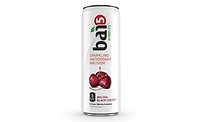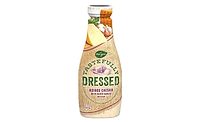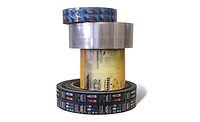As technology continuously shows us, reducing the size and weight of products is a major market trend. Last fall, Apple launched the iPad Air, which is 28 percent lighter and 20 percent thinner than the previous-generation iPad, the company says. Similarly, in the beverage packaging industry, companies have been working to achieve lighter-weight bottles to reduce costs and be more eco-friendly. However, this strategy can only stretch so far.
“Beverage brands are limited by how much further they can lightweight bottles, so they’re looking for alternative source-reduction avenues,” explains Scott Keefauver, marketing manager for Sealed Air Corp., Elmwood Park, N.J. “Downgauging labels has become a popular source-reduction strategy as a result,” he says.
For example, the company offers its Cryovac LT-1 multilayer shrink-sleeve label, which features a density lower than the 1 gram per cubic centimeter PET recycling standard.
Similarly, MRI Flexible Packaging offers its C-Fit Sleeve stretch-sleeve label, which offers a lower gram weight than most shrink-sleeve labels, says Jim Mallon, vice president of business development for the Newton, Pa.-based company. In fact, its specific density of less than 1 gram offers recycling benefits as well, as the material can be separated from PET in the recycling stream, the company says.
Most shrink sleeves, however, face recycling challenges because they tend to be denser labels, which are harder to separate from the PET in the recycling stream, explains Will Schretzman, vice president of packaging for Verst Group Logistics, Walton, Ky. To optimize PET bottle recycling with these labels, industry experts, brands and recyclers are collaborating to develop and implement recycling solutions, he says.
Such labeling innovations on the market have included floatable sleeves and perforated sleeves, both of which offer easy removal during recycling, he notes. “[This] will streamline the recycling process and put more recycled PET back into the system and out of landfills,” he says.
In general, shrink sleeves usually are not adhered to containers, which allows for easy removal, says Gwen Chapdelaine, marketing director for Fort Dearborn Co., Elk Grove, Ill. Their decorating abilities also offer packagers the opportunity to utilize single-colorant or clear containers and color them with labels instead, thereby reducing the waste of excess inventory for preprinted containers, she adds.
Strength in numbers
Other than these efforts to support the environment, stretch- and shrink-sleeve labels also play a role in supporting lightweight packages. “Wrapping a shrink-sleeve label around a lightweight bottle increases its durability and gives it an extra layer of protection,” explains Don Earl, president of Overnight Labels Inc., Deer Park, N.Y.
In some cases, packagers reduce the gram weight of the bottle to account for the cost of the label, Verst’s Schretzman says. In turn, the sleeve provides some top-load support for the lightweight bottle, he adds.
Of course, this support and protection only works if the package is stable, notes Lou Iovoli, vice president of strategic partnerships and marketing for Hammer Packaging, Rochester, N.Y. “If a bottle becomes so lightweight that it collapses in a user’s hand, then most likely it will not remain symmetrical under the pressure of a shrink sleeve,” he explains. “It really is a function of the shape, design and material selection.”
The right look
Beyond structural support, stretch- and shrink-sleeve labels can provide cosmetic support as well. For example, the label can be used to mask uneven fill lines on the shelf, Overnight Labels’ Earl says.
On the flipside of this, Sealed Air’s Keefauver notes that the company recently has received greater demand from its customers for clearer and more transparent labels. Consumers are calling for labels that allow them to see the product through the label, he says. As a result, Sealed Air is producing more labels that feature attractive graphics and branding but with optic capabilities that minimize haze, he says.
Whether see-through or not, stretch- and shrink-sleeve labels play an important role in marketing a product on-shelf, experts note. “There are a lot of options on today’s store shelves, and you can have a great product, but without the right packaging, you won’t catch consumer attention,” Hammer Packaging’s Iovoli says. “Labels create your product’s image on the store shelf and are what the consumer notices when they are browsing. With the right label, your product will stand out.”
By design, stretch- and shrink-sleeve labels offer 360-degree coverage, which translates to more billboard space for branding and product information than any other label type, Iovoli says.
New technology, including inks and material finishes, are helping beverage companies to make this label space even more eye-catching, Verst’s Schretzman adds. “Many of these advances have come in the past 10 years or so as the brands have requested more ways to make their products pop on the shelf,” he explains. Verst has partnered with more than 30 shrink-sleeve label converters to offer matte and soft-touch finishes, acid etch simulation, high-sheen metallic inks, cold foil stamping, embossing and thermochromatic inks to enhance shrink sleeves, he says.
These upscale enhancements are helping shrink-sleeve labels expand into beverage categories that traditionally have not utilized these types of labels in the past. “The wine and spirits industry has really started to grow in shrink [sleeves], as these new specialty sleeves have provided the high-end look they require that could only have been provided in the past with paper or pressure-sensitive labels,” Schretzman says.
Stretch- and shrink-sleeve labels also allow beverage-makers to package their products in uniquely shaped bottles to maximize shelf appeal, says Oguz Okur, partner at Etimag USA, Springfield, Va. “Shrink labels allow brand owners to be very creative with their label design and choice of bottle,” he says. “Historically, brand owners were limited in the shapes of the bottles and the types of label designs that they could use. Shrink labels remove most of these limitations and allow brand owners to be very creative.”
Shrink-sleeve labels, as their name implies, shrink to meet the contours of a package, explains Alcyr Coelho, vice president of sales and marketing for PDC-Europe (Americas) Inc., Austin, Texas. “Shrink sleeves are actually ‘under tension’ before application,” he says. “During the application of heat, they try to return to their natural state. At this point, they hit the walls of the containers, following their shapes.”
However, the heating component of applying shrink-sleeve labels can cause some warping issues with lightweight containers that prevent proper labeling, Verst’s Schretzman notes. During the application process, the labeler must align the optimal film shrink curve to the bottle in order to minimize or eliminate warping of the bottle, he explains. This becomes even more challenging with unique shapes, like oval or square bottles, because of placement and alignment issues. To overcome these challenges, the brand, sleeve converter, container supplier and decorator need to collaborate to reduce decorator error on these unique packaging shapes, he says.
Hammer Packaging also encourages collaboration between its customers and research and development team from the start to overcome such labeling issues. The company uses a 3-D scanner to scan the container, which creates a 3-D rendering on a computer, and applies the customer’s artwork to the rendering to create a digital file to show what the final product will look like. “This toolkit allows us to accommodate complex shapes [and] ensure accurate artwork distortion and gives our customers the opportunity to make any changes before going into production,” Iovoli explains.
The company also uses its Steambox Pro system to simulate a steam tunnel in the production of physical samples for the customer prior to full-on production. “This creates accurate samples and helps us to evaluate materials, assess artwork distortion, test new containers, or simply get a small quantity of prototypes,” Iovoli says. “Doing this extensive upfront work helps to lower the possibility of any errors during application.”
Stretch-sleeve labels skirt this issue because they do not require heat to apply, Coelho says. Instead, these labels are applied in a reverse manner: “A series of stretchers … pull the film evenly, avoiding causing permanent film distortion, and bring down the container,” PDC’s Coelho explains. “The [polyethylene] film then naturally hugs the containers, covering their curves.” However, unlike shrink-sleeve labels, high-elasticity polyethylene stretch-sleeves generally cannot be used to label glass containers and offer a 55 percent stretch ratio, compared with shrink sleeves’ 80 percent shrinking capability, he notes.
Competing for limelight
Because of their ability to conform to the shapes of their containers and offer 360-degree packaging coverage, stretch- and shrink-sleeve labels combined experienced the greatest increase in demand at 5 percent annually from 2007 to 2012 among all label types in the United States, reports The Freedonia Group Inc., Cleveland. In addition, the market research firm predicts that demand for these label types will continue to grow by 5.3 percent annually through 2017, challenging the dominant pressure-sensitive labels.
Despite the label types’ shared successes, Verst’s Schretzman and MRI Flexible Packaging’s Mallon both report that their companies receive more requests for shrink-sleeve labels than stretch-sleeve labels. Shrink-sleeve labels are more established and understood in the U.S. market, which is why customers tend to gravitate toward this option, Verst’s Schretzman says.
However, stretch sleeves are gaining momentum in Europe, especially in the dairy industry, as a lower-cost alternative to shrink sleeves, Schretzman notes. Stretch-sleeve labels typically offer a 30-50 percent cost savings compared with shrink-sleeve labels, MRI Flexible Packaging’s Mallon adds.
Right now, stretch-sleeve labels’ market share is in the low-single digits, PDC’s Coelho estimates. “Basically, there are only three U.S.-based converters [for stretch-sleeves]; there are over 70 shrink-sleeve converters in the U.S.,” he notes.
To help high-elasticity stretch-sleeve labels expand in the U.S. market, Verst purchased an entry-level application machine for testing and small-scale production to allow customers to try the technology, Schretzman says.
Further understanding of both label types should help the industry to keep pace with art and packaging changes in the future.
Materials 101: Shrink sleeves
Labeling companies are using several different material types to make shrink-sleeve labels, and even more options are on the horizon. Here’s a quick break-down of some of the more common material types and their properties from our experts.
Polyvinyl chloride (PVC) — PVC is a high-density film that shrinks at low temperature ranges, explains Don Earl, president of Overnight Labels Inc., Deer Park, N.Y. “The most commonly used shrink-sleeve material, PVC is the easiest film to control in the shrink process,” he explains. “It has excellent shrinkage rates, clarity and print quality and a wide range of both shrink temperatures and shrink ratios.” The scuff-resistant material currently has one of the lowest costs of the shrink-sleeve materials, but it is not as environmentally friendly as some of the other materials, he notes.
Polypropylene terephthalate glycol (PETG) — PETG is another high-density film with a high strength ratio and excellent clarity, Earl says. Although it tends to be the most expensive and most heat-resistant material option, it also is the most scuff-resistant material, offers a higher gloss, and has a higher shrink percentage, he explains. Additionally, PETG is pasteurizable and recyclable, he notes. PETG Low Vertical (or PETGLV) is a variation of this material that improves the vertical shrink, he adds. This type of material is especially useful for labeling large oval or square containers in order to avoid “reverse smiles,” says Alcyr Coelho, vice president of sales and marketing for PDC-Europe (Americas) Inc., Austin, Texas.
Polylactide (PLA) — PLA is a biodegradable thermoplastic made from renewable resources, Overnight Labels’ Earl says. This biodegradability has increased its popularity in recent years, he notes.
Oriented polystyrene (OPS) — OPS offers one of the lowest vertical shrinks of shrink-sleeve materials, according to Passion Labels and Packaging Inc., Sarasota, Fla. This material offers up to 75 percent shrink with minimal machine-direction (MD) shrinkage, the company says. In addition, it offers a softer feel, a more consistent finish, as well as environmental benefits, it says. As a cost-effective and environmentally friendly material, it often is used on containers that will be squeezed during label application, it adds.
Sealed Air Corp., Elmwood Park, N.J., combines the benefits of these materials into its multilayer films. These coextruded films combine the benefits of PETG, OPS and PVC polymers into a single film that offers both sustainability and functionality, says Marketing Manager Scott Keefauver. Even as a multilayer film, this material option is a lower-density material, which enables converters to produce 20 percent more shrink-sleeve labels per pound compared with some monolayer films, he says.
“These labels employ a print-friendly substrate within their exterior film layer that accommodates inks and seaming solvents to maximize design capabilities,” Keefauver explains.







